The Quiet Multifamily Home
How flooring choices can lessen excess noise
![]() Continuing Education
Continuing Education
Use the following learning objectives to focus your study while reading this month’s Continuing Education article.
Learning Objectives - After reading this article, you will be able to:
- Discuss the growing demand of multifamily housing and the role of flooring to alleviate a chief complaint: unwanted noise from other units.
- Recognize how sound blocking and absorption is measured in flooring and its overall benefits in building performance.
- Evaluate sound ratings for product selection best suited to budget and installation type.
- Identify the advancement of flooring technologies and their importance in the future of modern multifamily space design.
What happens when two opposing forces—the need for housing density and the need for quiet homes— converge? How does the architect, interior designer, or specifier create multifamily homes that are close in proximity and yet not noisy? Part of the answer lies in the choice of flooring, which can absorb and block unwanted sound from traveling between floors, thus contributing to the peaceful and quiet homes renters and owners want.

Photo courtesy of Mohawk Flooring
Residents in multifamily homes want the conveniences of density without the excess noise from adjacent units.
“The specification of flooring and underlayment pads play a tremendous role in making multifamily homes as quiet as single-family homes,” says David Moore, Senior Product Director for Mohawk Flooring. “For some of us, nothing is more irritating than hearing the neighbors upstairs walking around. Achieving superior acoustics between floors is very difficult to achieve after the fact. Ideally, the architect or designer understands how the flooring chosen for the project can create a quiet and relaxing environment for many years to come.”
The need for new apartments and condominiums is growing and will continue to grow. While a single-family home with a white picket fence may evoke the American Dream, the reality is that multifamily housing makes more sense on many levels: economic, demographic, and ecologic. Of the more than 43 million rental households in the United States, only 15 million live in single-family homes, while 26 million live in multifamily units.1 Even more live in owner-occupied apartments and luxury high-rises.
While enjoying the benefits of dense housing— such as shared amenities, city access, and affordability—the drawback can be noise that travels between units. Without attention to noise control, the sounds of common daily acts such as walking, talking, showering, and vacuuming will radiate from one unit to the other, diminishing the sensation of autonomous living. And when the neighbors are noisier than average, the irritation is greater.
Complaints about sound traveling through floors are rampant. And studies show that these unwanted sounds have negative effects on human bodies and moods.
SCIENTIFIC STUDIES ON THE EFFECTS OF NOISE ON THE BODY
In a 2017 paper titled “Effects of floor impact noise on psychophysiological responses,” it was noted that most research on environmental noise has analyzed long-term health consequences of transportation noise such as road traffic or airport noise, which is associated with elevated blood pressure, higher use of cardiovascular drugs, heart trouble, and hypertension.2
However, there have been fewer studies of health problems from noise in dwellings. This is despite the fact that people spend most of their time in or around their homes. One study identified associations between dissatisfaction with the noise from neighbors and mental health risks. Another study found that people who perceived neighbor noise as a severe annoyance experienced higher health risks, including cardiovascular disease. Some research found that various neighbor noises had adverse effects on sleep quality. In particular, they reported that “footstep noise was found to be one of the most disturbing impact noises from neighbors.” According to another study, “Annoyance induced by floor-impact noise has a reciprocal relationship with mental or physical health complaints.” The conclusion is that hearing the neighbors walking around upstairs can be more than a nuisance to some residents.
And it is not just at home but also at work, school, and in health-care settings that unwanted noise may have an adverse impact on occupants’ physical and mental well-being, which can in turn negatively affect an organization’s bottom line.
In educational learning environments, unacceptable noise levels can be directly correlated to student achievement and teacher stress. Acoustics figure prominently in health-care environments where patients require a quiet environment to heal, privacy is critical for patients and families, and health-care workers need to have clarity in their conversations about patients’ needs and instructions. In the hospital setting, noise leads to unsatisfied patients. According to the American College of Health Care Administrators (ACHCA), noise disruption routinely receives one of the lowest scores. Unsatisfied patients directly affect revenue for a hospital.
Study after study shows that flooring choices may have a substantial impact on noise and comfort.

Photo courtesy of Mohawk Flooring
Acoustics are increasingly being addressed as a factor in healthy homes.
IMPORTANCE OF SOUND RECOGNIZED BY DESIGN AND BUILD INDUSTRIES
Sound is increasingly recognized as a major factor in well-being. From an evolutionary aspect, hearing is arguably the most important sense developed to detect the approach of danger. While eyelids developed to block light as needed, ears did not develop lids to block sounds, as that would be dangerous, according to some theories. So rather than relying on functions of the body to block unwanted sounds, we must use engineering and design to block and absorb unwanted noise and create quiet. According to author Pico Iyer in his book The Joy of Quiet, times of quiet are “essential to our quality of life and to be able to think straight.” Sound expert Gordon Hempton, who calls himself an acoustic ecologist and sound tracker, says that “silence is an endangered species.”
In the design and build industries, concerns for quiet in the home are rising, with architects expanding their goals for indoor environmental quality (IEQ) to include acoustic performance. According to the Centers for Disease Control, IEQ is the quality of a building’s environment in relation to the health and well-being of those who occupy the space. In the quest to create a quiet multifamily home and less unwanted noise from apartments above, flooring can play an important role. It is helpful to understand how sound blocking and absorption are measured in floors, and this will be explained next.
HOW SOUND BLOCKING AND ABSORPTION ARE MEASURED IN FLOORING
As building codes have evolved, sound-control standards have been developed to determine the amount of noise allowed to penetrate through common walls and floors within dwellings. These standards are especially helpful for designers, builders, and owners when comparing various products to achieve sound-control goals.
Two standards are used to determine the amount of sound that transmits through flooring to the space below: impact insulation class (IIC) and sound transmission class (STC).
IIC Tests Impact Sounds from Above
IIC tests the ability of an assembly to block sound impacts and measure resistance to transmission of impact noise, such as footsteps, objects dropped on the floor, etc.

Image courtesy of Mohawk Flooring
Impact insulation class (IIC) testing measures the ability of an assembly to block sound impact and measures resistance to transmission of impact noise (footsteps, objects dropped on the floor, etc.).
The test is conducted using a “tapping machine” upstairs in the sending room, and a sound-measuring device downstairs in the receiving room.
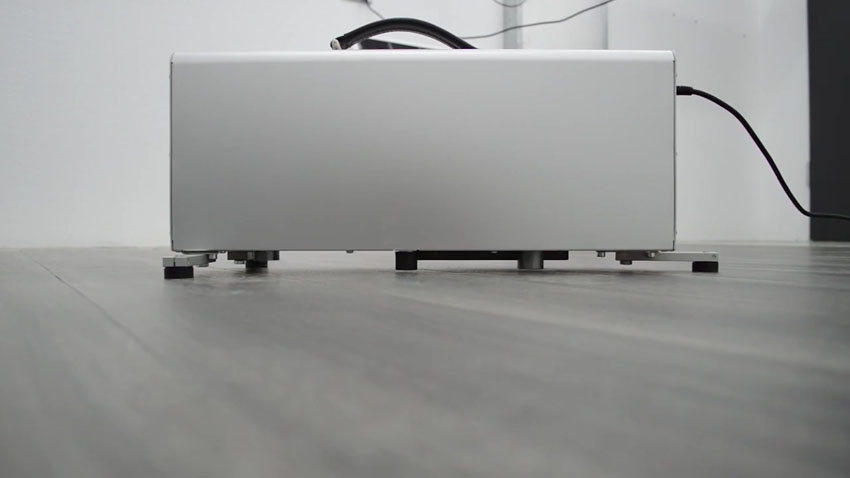
Image courtesy of Mohawk Flooring
A tapping machine is at work in the sending room.
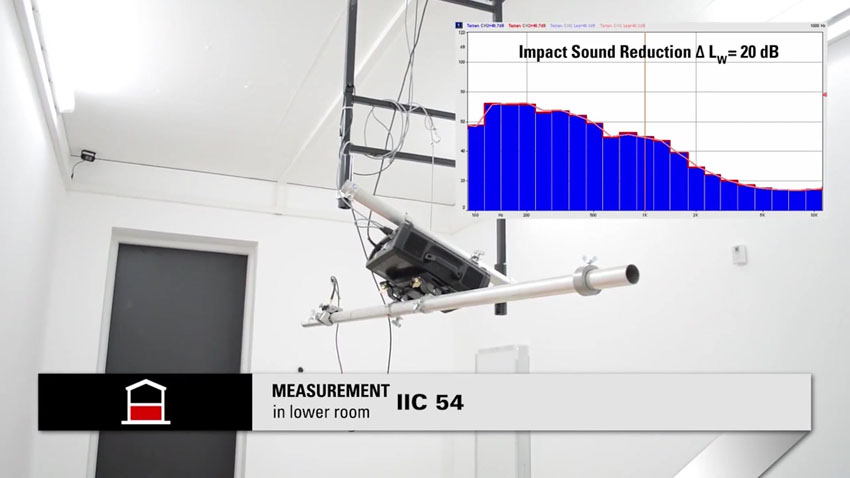
Image courtesy of Mohawk Flooring
A sound lab can recreate and detect a variety of noise agents in a multifamily dwelling.
The assemblies are tested according to ASTM E492 - 09(2016)e1: Standard Test Method for Laboratory Measurement of Impact Sound Transmission Through Floor-Ceiling Assemblies Using the Tapping Machine.
According to ASTM, “This test method is based on the use of a standardized tapping machine of the type specified in 8.1 placed in specific positions on the floor. This machine produces a continuous series of uniform impacts at a uniform rate on a test floor and generates in the receiving room broadband sound-pressure levels that are sufficiently high to make measurements possible beneath most floor types even in the presence of background noise. The tapping machine itself, however, is not designed to simulate any one type of impact, such as produced by male or female footsteps.”
STC measures the ability of a specific construction assembly to reduce airborne sounds (voices, audio systems, TV, etc.). The assemblies are tested according to ASTM E336 and ASTM E90.
The assemblies are tested according to ASTM E336-19: Standard Test Method for Measurement of Airborne Sound Attenuation between Rooms in Buildings.
STC Tests Airborne Sounds
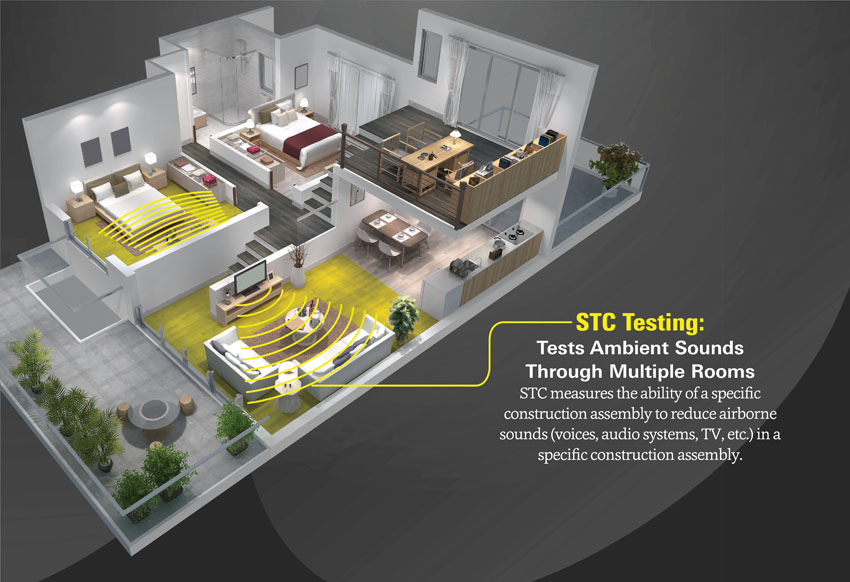
Image courtesy of Mohawk Flooring
Sound transmission class (STC) testing measures the ability of a specific construction assembly to reduce airborne sounds (voices, audio systems, TV, etc.).
According to ASTM, “The main part of this standard uses procedures originally developed for laboratory measurements of the sound-transmission loss of partitions. These procedures assume that the rooms in which the measurements are performed have a sound field that reasonably approximates a diffuse field. Sound-pressure levels in such rooms are reasonably uniform throughout the room, and average levels vary inversely with the logarithm of the room sound absorption. Not all rooms will satisfy these conditions. Experience and controlled studies have shown that the test method is applicable to smaller spaces normally used for work or living, such as rooms in multifamily dwellings, hotel guest rooms, meeting rooms, and offices with volumes less than 150 cubic meters.”
The International Building Code (IBC) calls for a rating of 50 in the test laboratory for both IIC and STC, and a rating of 45 when tested in the field. The higher the number, the quieter the room.
The assemblies are tested according to ASTM E-90: Standard Test Method for Laboratory Measurement of Airborne Sound Transmission Loss of Building Partitions and Elements.
According to ASTM, “This test method covers the laboratory measurement of airborne sound-transmission loss of building partitions, such as walls of all kinds, operable partitions, floor-ceiling assemblies, doors, windows, roofs, panels, and other space-dividing elements.”
Following is a breakdown of the test results.
- STC-ICC 70 is just about soundproof.
- STC-ICC 60 is superior soundproofing.
- STC-ICC 50 is acceptable soundproofing according to the IBC.
- STC-ICC 40 is soundproofing that is below most codes.
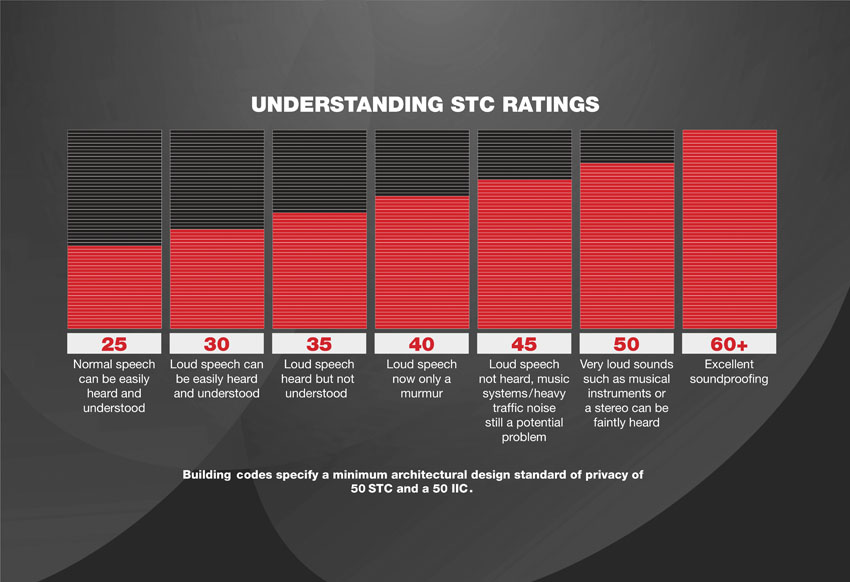
Image courtesy of Mohawk Flooring
While IIC and STC test results can show how individual products affect the soundproofing of the assembly, note that the results are for the entire assembly and not just the product. When a manufacturer indicates IIC and STC test results, the exact assembly tested will be described. Acoustical performance differs over various floor coverings, such as concrete and open-web wood truss floor/ceiling assemblies.
A little understood fact is that a higher IIC/STC rating is not always better above a certain point. Some specifiers indicate a general rating to satisfy their preference without having understanding of IIC/STC ratings data. Some flooring companies have taken time to understand IIC/STC ratings on their flooring products to help architects, designers, and specifiers make a sound decision. The human ear cannot distinguish much difference between an IIC of 55 versus an IIC of 62 on an open-web truss.
SOUND RATINGS FOR VARIOUS FLOOR PRODUCTS AND UNDERLAYMENT PADS
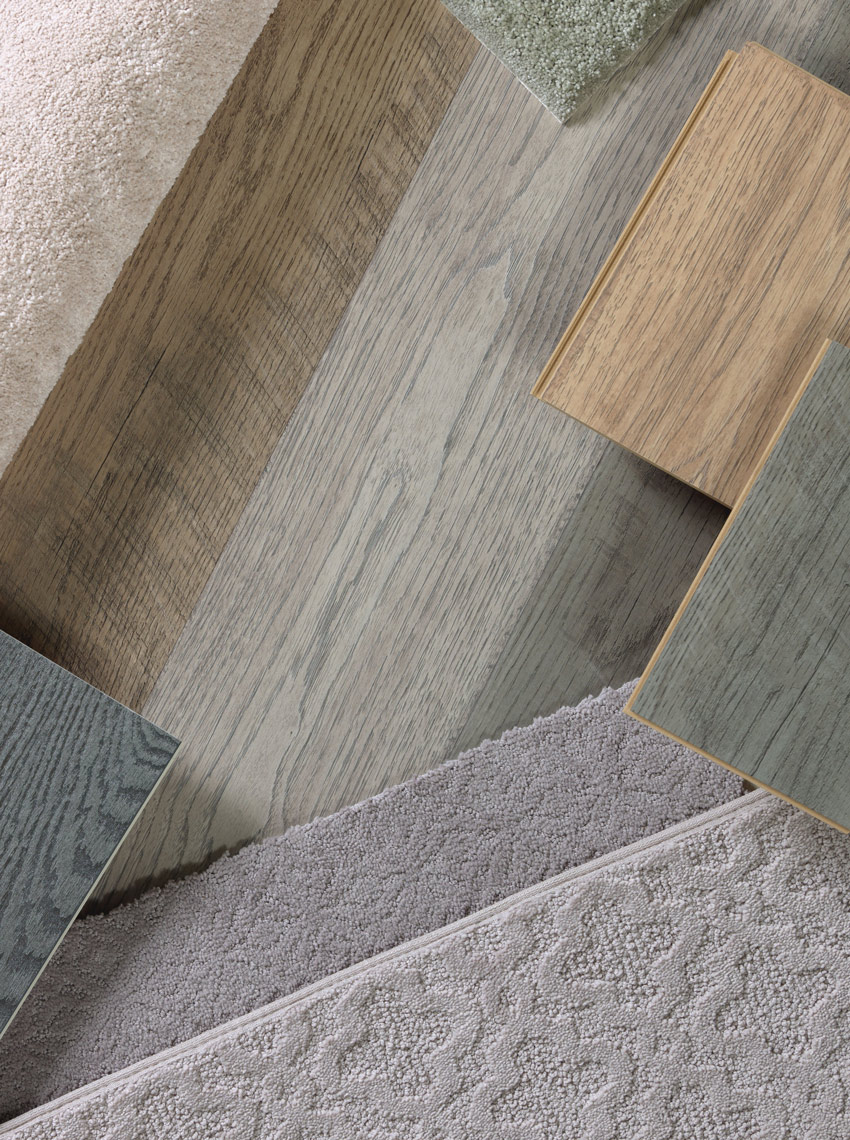
Image courtesy of Mohawk Flooring
Different flooring choices will have different IIC and STC ratings.
Various flooring choices generate different IIC and STC ratings. Those are enhanced with sound-blocking and sound-absorbing underlayment pads.
Click here to hear the differences when underlayment padding is added.
Let’s consider luxury vinyl tile (LVT) and planks (LVP), luxury sheet vinyl, laminate, and carpeting individually. But first, it is helpful to understand common flooring terminology.
Flooring Terms

Image courtesy of Mohawk Carpeting
When discussing flooring, it is helpful to understand several terms, including gauge, millimeters, ounces, and mils. Following are definitions.
- Gauge is used to measure the thickness of sheet vinyl flooring; for example, 65 gauge equals 0.65 inch.
- Ounce is the weight of the carpet’s fibers in 1 square yard of flooring.
- Millimeters are used to describe the thickness of flooring.
- Mils are one-thousandth of an inch, or 0.001 inch. One mil also equals 0.0254 millimeter and is used to measure the wear layer or protective-coating thickness in flooring.
LUXURY VINYL FLOORING
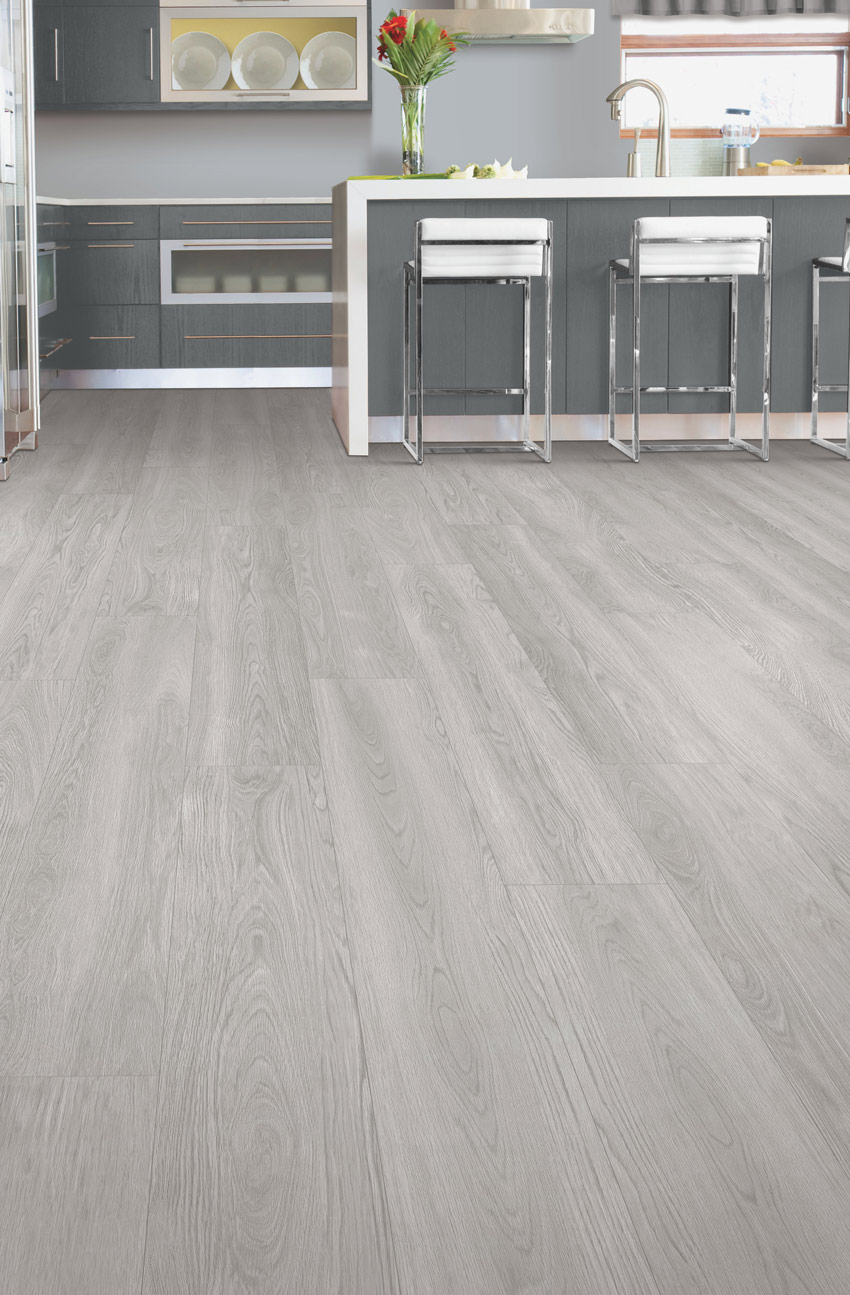
Photo courtesy of Mohawk Carpeting
It is not the same vinyl from decades ago.
Vinyl flooring is a prime example of a product whose current state of quality is vastly improved from selections available decades ago. Today’s luxury vinyl features some of the most innovative, versatile, and high-performing flooring available. Premium vinyl flooring offers the richness and texture of more expensive natural materials, such as hardwood, ceramic tile, and stone, without maxing out a multifamily unit budget. It is offered in tile, plank, and sheet formats.
Luxury vinyl is strong but soft underfoot, maintaining a comfortable temperature in all seasons. But not all luxury vinyl products are equal. Higher-quality vinyl flooring resists the damaging impacts of heat and sunlight, maintaining its shape and stability even at temperature extremes. Vinyl is waterproof, which makes it suitable for kitchens or other high-traffic areas such as living rooms or dens. Higher-quality LVT), LVP, and sheet vinyl includes a durable, protective top layer that resists scratches, dents, and stains from family pets. These offer high-end looks without the high-end price tag, and there is generally a selection of hardwood and stone visuals lend elegance to any room.
Some LVPs include a locking system that keeps planks tightly in place and eliminates adhesive costs. That means they install quickly for move-in-ready floors. Some higher-quality LVPs have no-polish maintenance, which would appeal to buyers and building owners.
In terms of sustainability, look for products that are FloorScore Certified, CARB II Certified, and may contribute to or comply with LEED credits.
Layers of Luxury Vinyl Flooring

Image courtesy of Mohawk Flooring
Layers of luxury vinyl flooring are depicted here.
Luxury vinyl is not a one-dimensional material. Consider the technologically advanced layers that make up the LVT of a major manufacturer:
- Stain-shielding layer: This is a stain-resistant surface coating that protects against scuff, scratches, and the toughest stains, and makes cleaning simple.
- Wear layer: An embossed wear layer feels like real wood grain and resists dents, scrapes, scratches, and everyday wear so floors look newer longer.
- HD print layer: High-definition printing reproduces visual effects with ultimate clarity for the most realistic looks.
- PVC layer: A solid PVC inner core provides both stability and sound insulation while linking LVF layers together.
- Fiberglass core: A webbed fiberglass core encapsulated by two PVC layers provides strength and flexibility while ensuring easier installation, added stability, and a longer life.
- PVC backing layer: Solid PVC backing made from recycled content provides a strong foundation for greater stability and easier installation.
Misconceptions about LVT and LVP
Myth: LVT and LVP are just the same old vinyl with a fancy name.
Reality: Modern luxury vinyl not only looks remarkably like the real wood or stone, but it also has superior performance to withstands spills, scuffs, and even scratches from family pets. Its tight, waterproof fit and resilient surface make for easy cleanup that will not damage subfloors. It is quiet and comfortable, and softer underfoot for better cushion and sound absorption. It barely resembles the thin, fake-looking vinyl flooring products of decades ago.
Sound Ratings for LVT
LVT generally comes with or without padding attached. Even without padding, on an 18-inch open-web truss, the IIC ratings may range from 48 to 51 depending on the thickness of the product. With an underlayment of 1-millimeter foam, the IIC ratings range from 51 to 54. The STC ratings can be extremely high, running as high as 58.
Underlayment Pads for LVT with Acoustical Benefits
There are several types of underlayment pads for LVT that have acoustical benefits. A polypropylene acoustical underlayment for use with glue-down LVT provides excellent sound reduction and moisture protection under luxury vinyl flooring, making it an asset for multilevel installations. It is designed to secure the flooring to the pad and the pad to the substrate. The dense foam design fights against mold and mildew, is moisture and vapor resistant, and nontoxic and odorless.
Another type of underlayment pad for floating LVT improves tenant comfort by offering superior acoustics- and subflooring-correcting properties for fast installations. The foam construction absorbs ambient noise and sound transmission between floors. Depending on the manufacturer, there may be a gripping technology that prevents seam separation under heavy commercial traffic. The cushion offers some subfloor correction and reduces footfall impact for added comfort. According to testing by one manufacturer, this type of pad can give the LVT a rating of 72 IIC or 66 STC on a 6-inch concrete slab with a drop ceiling below. It provides 54 IIC or 50 STC over a 6-inch concrete slab with no drop ceiling below. And it even offers thermal resistance with an R-value of 6.6.
LUXURY SHEET VINYL

Image courtesy of Mohawk Flooring
Luxury sheet vinyl offers realistic visuals and a high level of comfort.
Today’s luxury sheet vinyl is some of the most innovative, versatile, and high-performing available. Premium vinyl sheet flooring offers the richness and texture of more expensive natural materials, such as hardwood, ceramic tile, and stone, without the cost. While luxury vinyl is offered in tiles and plank, even in sheet formats, luxury vinyl flooring boasts realistic visuals, easy installation, and a high level of comfort.
Luxury sheet vinyl is strong but soft underfoot, maintaining a comfortable temperature in all seasons. Depending on the manufacturer, high-quality vinyl flooring resists heat and sunlight, maintaining its shape and stability even at temperature extremes. Vinyl is waterproof, which makes it an appropriate specification for kitchens, bathrooms, or other high-use areas such as a livings room or dens.
Misconceptions about Sheet Vinyl
Myth: Sheet vinyl’s aged look is not right for today’s aesthetic.
Reality: It is understandable that the old, yellowed vinyl sheeting that one saw at a grandparent’s house or in a low-cost rental gets stuck in the memory banks. But fast-forward to the technologies of the past few years, and the picture totally changes. The high-definition print layer is enough to be a game changer, allowing the sheet vinyl to replicate much more expensive products such as wood and stone, but without depleting those natural materials. The wear layers above that keep the flooring looking new, resisting scuffs and stains. Many of these technologies were unheard of just a few years ago. The fiberglass core keeps the sheets stable and so resistant to curling that they can be installed with minimal adhesives.
Layers of High-Quality Sheet Vinyl

Image courtesy of Mohawk Flooring
High-quality sheet vinyl is composed of several layers.
High-quality resilient vinyl sheet may include several layers, including, from bottom to top:
- a backing layer;
- a fiberglass layer and PVC core;
- a high-definition design layer;
- an enhanced urethane layer; and
- a clear wear layer and stain shield.
Sound Ratings for Sheet Vinyl
Sound ratings for high-quality sheet vinyl with a 55-gauge fiberglass core on an 18-inch open-web truss may be around 50 for IIC and 57 for STC.
LAMINATE FLOORING
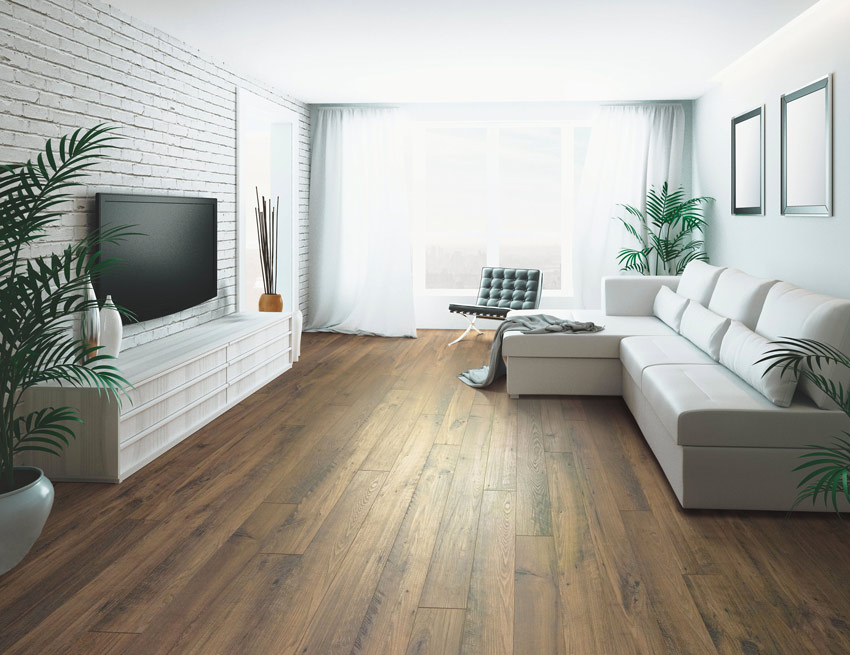
Image courtesy of Mohawk Flooring
Modern laminate flooring is durable and sophisticated.
It is easy to see why laminate flooring has become so popular with its hardwood and stone looks that add sophisticated style to a home for less. Laminate wood flooring is easy to install, easy to clean, and easy to maintain. Further, laminate can be an environmentally friendly flooring option, often made with recycled materials and requiring no harvesting of rare trees. Laminate floors are durable and resistant to both staining and fading, providing worry-free assurance that the floor specified for multifamily homes will not lose its appearance.
Some laminate flooring features tight, waterproof joints and top coats that allow for wet-mopping and protect against everyday spills, and a protective wear layer that resists scratches and scuffs. In fact, this technologically advanced laminate flooring can even be specified in basements with acceptable subfloor moisture levels, though not in rooms with floor drains or sump pumps. In this advanced laminate, the perimeter of each plank is coated with a hydrophobic coating that repels water so planks resist swelling from moisture.
Other innovations that make some brands of laminate flooring desirable include a glueless locking system that snaps together for ease of installation. This system maintains constant tension between planks for tight joints that trap water on the surface, protecting the floor and subfloor. Further, edges with pressed bevels allow the surface visual and protective coating to wrap over the plank’s edge, enhancing the hardwood realism while protecting the core from moisture.
Layers of Laminate Flooring
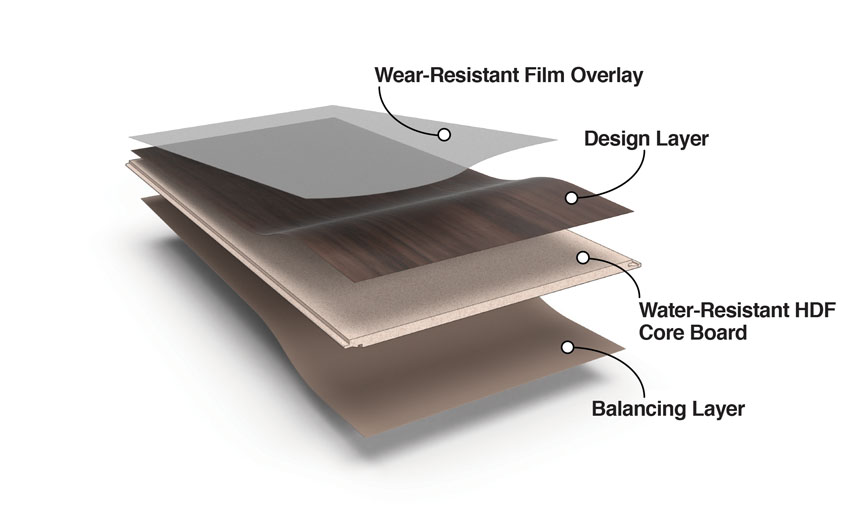
Image courtesy of Mohawk Flooring
Many layers of laminate flooring account for its long-wearing aesthetic.
Layers of laminate flooring may include, from the bottom up:
- a balancing layer;
- a water-resistant HDF core board;
- a design layer; and
- a wear-resistant film overlay.
Misconceptions about Laminate Flooring
Myth: Laminate floors will not wear well.
Reality: As with vinyl flooring, this myth is based on the first generation of laminate flooring that could get scuffed prematurely. Modern, multilayered laminate floors from trusted, quality manufacturers are designed and built for maximum durability.
Myth: Laminate and luxury vinyl plank flooring are the same thing.
Reality: Though sheet or vinyl tiles will look different from laminate or luxury vinyl planking, the two latter products may look the same. But the main difference is in the core of the material and how they are layered. Laminate flooring’s core is typically made from material derived from wood, while luxury vinyl flooring is composed of completely synthetic materials.
Myth: Laminate flooring is not as visually appealing as real wood or stone floors.
Reality: Some of us have laminate flooring from a few decades ago seared into our memories. But like many other building materials, there have been great advances in styles, textures, and designs for laminate flooring. With technologies to add high-definition imaging and textures, along with technologies to make laminates wear and water resistant, the newest improvements make it almost unrecognizable from earlier products.
Laminate Flooring Sound Ratings
Because of its layered construction, laminate flooring has surprising good IIC and STC ratings for acoustics. For instance, two types of laminate flooring from one manufacturer have ratings of 54 and 57 IIC, and 58 STC, both on a 6-inch concrete slab. Both are well above the IBC minimum of 50 as tested in a sound laboratory.
Laminate Underlayment Pads
Underlayment pads can improve the ratings even more. For instance, adding a cross-linked polypropylene underlayment with a thickness of 2 millimeters can help laminate flooring achieve an IIC of 71 and an STC of 73. This type of advanced acoustic pad reduces hollow tapping noises, producing a sound very close to actual hardwood. And there are other advantages to such a pad. A thick preattached moisture barrier helps protect flooring from moisture damage and is itself resistant to mold, mildew, and bacteria growth. The pad is easy to install with attached lip and tape, and it is safe for under-floor heating for luxury multifamily homes. It can even add R-value to the floor. R-value is the capacity of a material to resist the flow of heat. One popular pad for laminate floors add an R-value of 3.2.
CARPETING
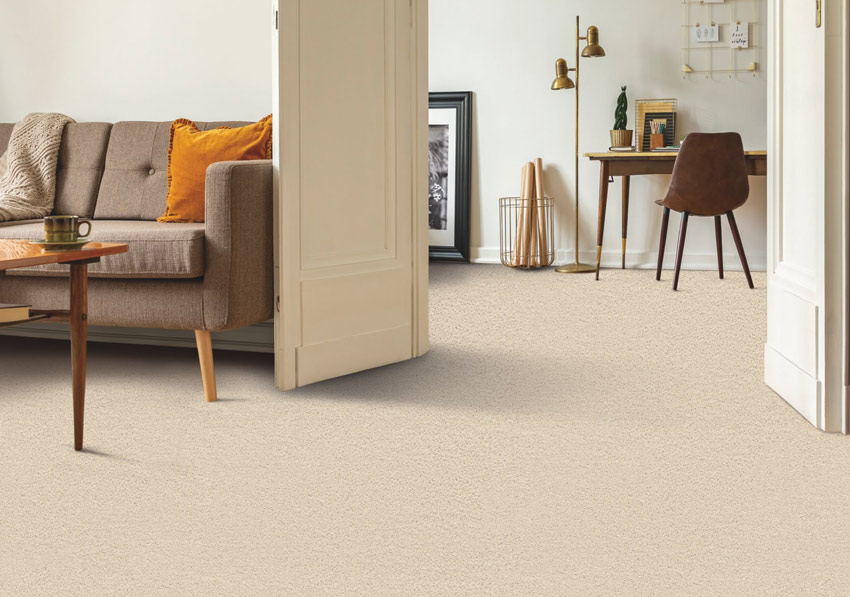
Image courtesy of Mohawk Flooring
Carpeting is well-known for providing good acoustic qualities in multifamily homes.
There are four main constructions of carpeting: loop, pattern, texture, and frieze.
Loop construction carpet has dense, looped strands and a low profile for a clean, low-maintenance look. This style is durable, reliable, and ideal for high-traffic areas.
Pattern construction carpet is made with varying loop and cut heights for looks that range from bold and dramatic to simple and understated. This low-profile style is appropriate for high-traffic areas.
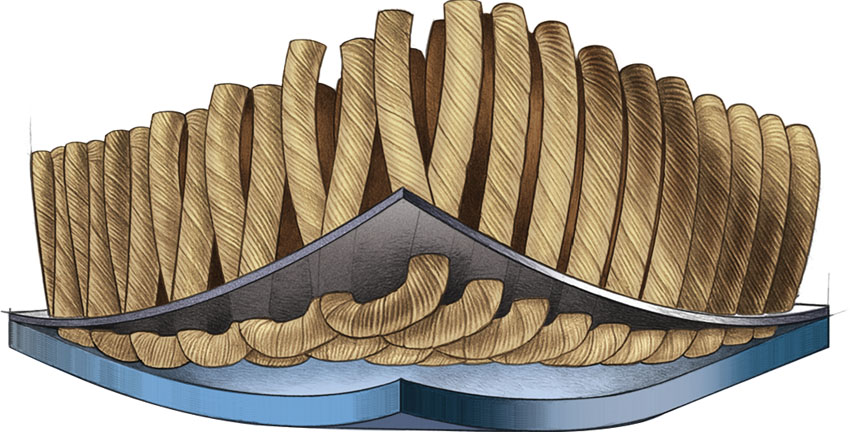
Image courtesy of Mohawk Flooring
Shown is texture construction carpet.
Texture construction carpet (shown above) has long, crimped yarns for a casual look. With higher pile for a soft feel, it tends to be a popular style.
Frieze, or twist construction, carpet has high, twisted yarns for a longer crimped look and relaxed feel. Its long twists create dimension and visual interest as well as a bouncy, springy feel underfoot.
Innovations in carpet construction make it much more livable than in the past. For instance, fiber-washed polyester resists stains to keep the multifamily resident’s carpet looking newer longer. Carpeting made of polyester, nylon, and triexta fiber are all stain and wear resistant.
Misconceptions about Carpeting
Myth: Yes, the acoustical benefits are great, but people with asthma and allergies should avoid carpet in the home.
Reality: Actually, the opposite is true. Studies have shown that properly cleaned carpet helps reduce symptoms and can be the best flooring choice for those dealing with asthma and allergies.
The reason: Gravity causes common household particles, such as dust, pollen, and pet and insect dander, to fall to the floor. Carpet fibers trap the particles, removing them from the breathing zone and reducing their circulation in the air. Regular vacuuming effectively removes dust and allergens from the carpet and helps keep them out of the air occupants breathe. Although carpeting is not normally associated with improved indoor air quality, it can have a very positive effect. Carpet is among the lowest volatile organic compound (VOC) emitting flooring choices available. The Carpet and Rug Institute’s Green Label Plus Indoor Air Quality Standard identifies carpet, adhesive, and cushion products that meet or exceed government indoor air quality regulations and are among the lowest VOC-emitting products on the market. For best results, look for carpets that are CRI Green Label Plus certified.
Sound Ratings for Carpeting
Carpeting is associated with a quieter home and for good reason. The STC ratings of carpeting are especially high. For instance, the IIC ratings for one manufacturer’s 25-ounce cut pile carpet with a 7/16-inch 5-pound foam cushion underlayment is 76, and the STC rating is 59. When you consider that the IBC calls for an IIC and STC ratings of 50 in the testing laboratory and 45 in the field, that is a significant increase.
Types of Acoustic Pads for Carpeting
Bonded urethane foam, also known as rebond, is the most common type of carpet pad material. However, a thick pad allows much up and down movement, which can wear out the carpet backing prematurely as it flexes.
One type of pad with acoustic benefits is a visco-elastic memory foam construction that softens steps and improves insulation for a quieter, more energy-efficient room. By absorbing and deflecting foot traffic, this type of padding also prolongs the life of the carpet by defending it from abrasive wear. And when it comes to spills, the pad may include a moisture-blocking feature, preventing moisture from soaking into the subfloor.
Synthetic Pad versus Urethane Pad: Common Misconception
Carpet pad is generally made from either urethane foam (rebond) or synthetic fibers. While rebond has significant traction in certain regions—particularly the southeast and southcentral United States—as the go-to option for residential carpet pad, it may not always be the best option. At least one flooring manufacturer offers a synthetic pad made of 100 percent post-industrial recycled material, which may fit into some green building goals.
Here are some common misconceptions about synthetic pad made of 100 percent recycled materials.
Misconception: Rebond is cheaper than synthetic pad.
Reality: This used to be true. However, because some synthetic pad is made from recycled material, it is now cost-competitive with rebond pad.
Misconception: Recycled material is weaker and does not perform as well.
Reality: This might have been true at one time for some recycled products, but it simply is not true for synthetic carpet pad. A nonwoven manufacturing process ensures superior durability.
Misconception: Rebond is better for residential use.
Reality: It is true that rebond is more commonly found in residential areas in certain regions. But not only is synthetic pad demonstrably more durable, it also holds up against heat. In fact, synthetic pad is the only carpet pad that is rated for use with radiant heating.
Misconception: Synthetic materials contain harmful chemicals.
Reality: Quite the opposite. Synthetic pad does not contain chemical flame retardants found in polyurethane foam, making it a popular choice among the health-conscious.
Misconception: Synthetic pad is for commercial use only.
Reality: For commercial applications, synthetic pad has been an industry go-to because urethane foam will not last under high traffic. However, this is precisely what makes it well-suited for residential use, and perhaps even more so for multifamily housing, where the occupancy may turn over frequently. More durability means carpet stays in better shape for a longer period of time.
ADVANCEMENTS IN FLOORING TECHNOLOGIES AND FUTURE TRENDS
Just the past few years have seen tremendous advancements in technologies for flooring. These are certain to have an effect on the design and building of multifamily homes in the future. Following are some technologies and trends of which to be aware.
Waterproof Flooring Systems
LVT and LVP are examples of products that resemble wood and stone, and yet are impervious to moisture and the problems it creates. A home in Texas during Hurricane Harvey in 2017 provides an example. After the home flooded with several feet of water, the drywall and insulation needed to be completely removed and replaced—but the LVPs suffered no damage. They were lifted up to allow the subfloor to dry and then reinstalled like new.
Water-Resistant Flooring Systems

Image courtesy of Mohawk Flooring
Water-resistant flooring systems are trending.
While some products like high-quality laminate flooring are not strictly waterproof, they can come pretty close to that with new technologies. One manufacturer has developed a system of pressed beveled edges that keep moisture from infiltrating the product core or the subfloor. In some cases, a perimeter coating of the laminate planks offers an even higher level of moisture resistance.
Click-Together Flooring Systems

Image courtesy of Mohawk Flooring
Flooring systems that click together cut down on labor costs and adhesive use.
Innovative click-together flooring systems are designed to maintain constant tension between planks. These click-together systems are ideal for easy floating installation, which not only cuts down on labor and adhesive costs, as well as possible VOC emissions, but also creates a consistently stable floor with no buckling.
Flooring that Forgives Imperfections in Subfloor and Humidity Levels
The latest innovation in vinyl flooring is LVT and LVP with a rigid, waterproof core. The tiles and planks lock together for a waterproof floor that will not telegraph imperfections from the subfloor. Installation is quick and easy, and can be done in any room of the house, no matter the humidity levels or fluctuations in temperature. This provides superior performance in wet areas such as basements and bathrooms, and provides easy maintenance for spills.
Fresh and Clean Carpet Technology
New technologies have created odor-resistant carpet for reducing household odors and keeping a multifamily home clean and fresh. The secret to odor-resistant carpet is innovative odor neutralizing technology. That is on top of treatments that resist stains and moisture.
Green Building Scores for Acoustics
The green building industry is starting to promote acoustic performance within its standards. The WELL Building Standard includes a Sound concept that “aims to bolster occupant health and well-being through the identification and mitigation of acoustical comfort parameters that shape occupant experiences in the built environment.” LEED v4 includes an acoustic performance credit. FloorScore is a good indicator of how healthy a flooring product will be for the occupants.
Sustainability
Sustainability will continue to be hot-button concept for the design community and the flooring industry. For instance, the world’s largest flooring company has diverted more than 3 billion plastic bottles from landfills by recycling them into carpeting. This premium PET polyester fiber is thoroughly purified for the cleanest strand and easy to keep clean with advanced soil and stain protection. The patented process takes premium PET from the highest-grade polymer, strengthens the fiber, and removes dirt-attracting residue with a multistep purification system. And, with up to 100 recycled content, it is the world’s most sustainable carpet.
CONCLUSION
The need for and appeal of high-density, multifamily housing will continue to grow, and so will the desire of residents to live in homes that are quiet and free from the irritations of hearing the neighbors upstairs. These unwanted noises can actually cause tension and illness. One of the most effective methods for cutting down on noise from an upstairs unit to the one below is the specification of flooring and underlayment pads that absorb and block these sounds. While the IBC calls for IIC and STC ratings of 50 in the laboratory and 45 in the field, the higher the number, the more peaceful the home. Luxury vinyl is a perfect example of a flooring with extremely high STC ratings and IIC ratings that are substantially raised with the right acoustic underlayment padding. After the multifamily development is complete, it will be very hard to address sound transmission problems once the residents have moved in. With a knowledgeable architect or specifier choosing flooring with higher IIC and STC ratings, the residents will more likely enjoy their quiet homes for many years to come.
END NOTES
1“Quick Facts: Resident Demographics.” National Multifamily Housing Council. Web. 9 Oct. 2019.
2Park, Sang Hee and Lee, Pyoung Jik. “Effects of floor impact noise on psychophysiological responses.” Building and Environment. Volume 116. May 2017. Web. 9 Oct. 2019.
